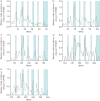Increased incidence of adult pneumococcal pneumonia during school holiday periods
- PMID: 28326311
- PMCID: PMC5349095
- DOI: 10.1183/23120541.00100-2016
Increased incidence of adult pneumococcal pneumonia during school holiday periods
Abstract
Child contact is a recognised risk factor for adult pneumococcal disease. Peaks in invasive pneumococcal disease incidence observed during winter holidays may be related to changes in social dynamics. This analysis was conducted to examine adult pneumococcal community-acquired pneumonia (CAP) incidence during school holiday periods. Between September 2008 and 2013, consecutive adults admitted to hospitals covering the Greater Nottingham area with a diagnosis of CAP were studied. Pneumococcal pneumonia was detected using culture and antigen detection methods. Of 2221 adults studied, 575 (25.9%) were admitted during school holidays and 643 (29.0%) had pneumococcal CAP. CAP of pneumococcal aetiology was significantly more likely in adults admitted during school holidays compared to term time (35.3% versus 26.7%; adjusted OR 1.38, 95% CI 1.11-1.72, p=0.004). Over the 5-year period, the age-adjusted incidence of hospitalised pneumococcal CAP was higher during school holidays compared to term time (incident rate ratio 1.35, 95% CI 1.14-1.60, p<0.001); there was no difference in rates of all-cause CAP or non-pneumococcal CAP. Reported child contact was higher in individuals with pneumococcal CAP admitted during school holidays compared to term time (42.0% versus 33.7%, OR 1.43, 95% CI 1.00-2.03, p=0.046). Further study of transmission dynamics in relation to these findings and to identify appropriate intervention strategies is warranted.
Conflict of interest statement
Conflict of interest: Disclosures can be found alongside this article at openres.ersjournals.com
Figures

Similar articles
-
Serotype prevalence in adults hospitalised with pneumococcal non-invasive community-acquired pneumonia.Thorax. 2012 Jun;67(6):540-5. doi: 10.1136/thoraxjnl-2011-201092. Epub 2012 Feb 28. Thorax. 2012. PMID: 22374921
-
Pneumococcal serotype trends, surveillance and risk factors in UK adult pneumonia, 2013-18.Thorax. 2020 Jan;75(1):38-49. doi: 10.1136/thoraxjnl-2019-213725. Epub 2019 Oct 8. Thorax. 2020. PMID: 31594801
-
13-Valent vaccine serotype pneumococcal community acquired pneumonia in adults in high clinical risk groups.Vaccine. 2018 Mar 14;36(12):1614-1620. doi: 10.1016/j.vaccine.2018.02.005. Epub 2018 Feb 10. Vaccine. 2018. PMID: 29439865
-
Burden of pneumococcal community-acquired pneumonia in adults across Europe: A literature review.Respir Med. 2018 Apr;137:6-13. doi: 10.1016/j.rmed.2018.02.007. Epub 2018 Feb 19. Respir Med. 2018. PMID: 29605214 Review.
-
Pathogenesis and prevention of risk of cardiovascular events in patients with pneumococcal community-acquired pneumonia.J Intern Med. 2019 Jun;285(6):635-652. doi: 10.1111/joim.12875. Epub 2019 Jan 29. J Intern Med. 2019. PMID: 30584680 Review.
Cited by
-
Effectiveness of the 23-valent pneumococcal polysaccharide vaccine against vaccine serotype pneumococcal pneumonia in adults: A case-control test-negative design study.PLoS Med. 2020 Oct 23;17(10):e1003326. doi: 10.1371/journal.pmed.1003326. eCollection 2020 Oct. PLoS Med. 2020. PMID: 33095759 Free PMC article.
-
Alterations in the prevalence and serotypes of Streptococcus pneumoniae in elderly patients with community-acquired pneumonia: a meta-analysis and systematic review.Pneumonia (Nathan). 2025 Feb 25;17(1):5. doi: 10.1186/s41479-025-00156-0. Pneumonia (Nathan). 2025. PMID: 39994753 Free PMC article. Review.
-
Seasonal Incidence of Community-acquired Pneumonia: A Retrospective Study in a Tertiary Care Hospital in Kathmandu, Nepal.Cureus. 2019 Dec 18;11(12):e6417. doi: 10.7759/cureus.6417. Cureus. 2019. PMID: 31988818 Free PMC article.
References
-
- Nuorti JP, Butler JC, Farley MM, et al. . Cigarette smoking and invasive pneumococcal disease. Active Bacterial Core Surveillance Team. N Engl J Med 2000; 342: 681–689. - PubMed
-
- Vila-Corcoles A, Aguirre-Chavarria C, Ochoa-Gondar O, et al. . Influence of chronic illnesses and underlying risk conditions on the incidence of pneumococcal pneumonia in older adults. Infection 2015; 43: 699–706. - PubMed
-
- Lipsky BA, Boyko EJ, Inui TS, et al. . Risk factors for acquiring pneumococcal infections. Arch Intern Med 1986; 146: 2179–2185. - PubMed
-
- Rodrigo C, Bewick T, Sheppard C, et al. . Pneumococcal serotypes in adult non-invasive and invasive pneumonia in relation to child contact and child vaccination status. Thorax 2014; 69: 168–173. - PubMed
LinkOut - more resources
Full Text Sources
Other Literature Sources
Miscellaneous
